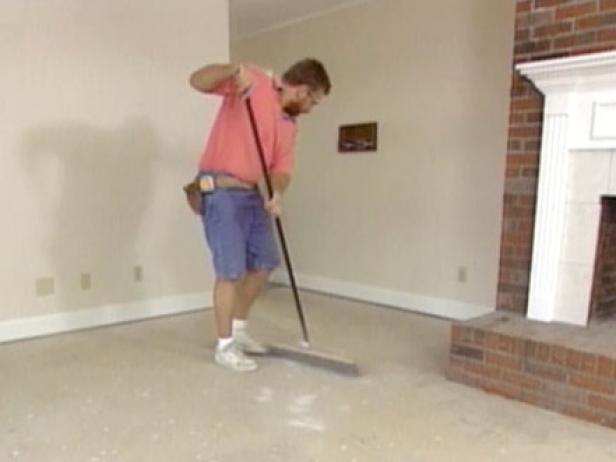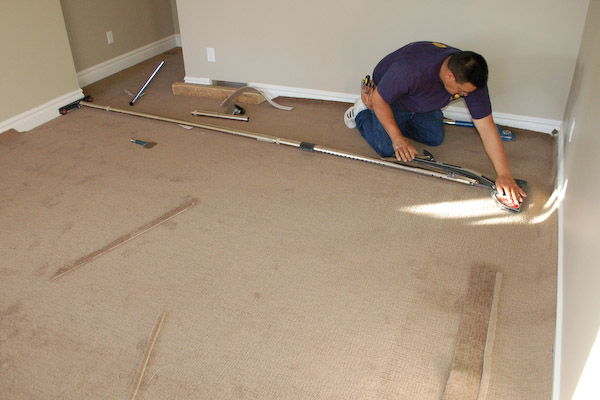When it comes to installing carpet in your home, some people may think opting for a do-it-yourself installation is a great way to save money. The reality of the situation is, while you can install your own carpet, it is a difficult job for a novice. In most cases, it is easier to pay a professional to install the carpet for you because you will end up with less hassle, and a quality job in the end.
First of all Installing carpet requires the use of certain specialty tools. You have to obtain these tools and gather the materials that you need:
Specialty Tools
- tack strip cutter
- measuring tape
- hand stapler
- top cutter
- wall trimmer
- knee kicker
- carpet knife
- hammer
- stair tool
- power stretcher
- razor knife
- gloves
Materials
- carpet
- tackless strip
- tape
Determine the Area of the Room
Measure the longest walls in your room. Multiply the length and width, and divide by 9 to determine the square yardage. Add 10 percent to allow for errors, irregularities and pattern matching
Clean the Subfloor
Clean and prep the floor. Cut lengths of tackless strip to fit each wall around the perimeter of the room. Secure them with the pre-driven nails into the subfloor, keeping the strip out from the wall about 2/3 the thickness of the carpet. Make sure the tackless strips join together at the corners and the pointed pins in each strip are facing the wall.

Remove the Doors
If possible, remove the doors from the room so you won’t have to work around them. Having the doors out of the way will also make it easier for you to cut off the bottoms of the doorjambs if necessary.

Install the Tackless Strips
Cut the tackless strips to size with a strip cutter or heavy snips (Image 1). Nail the strips 1/2″ from the wall (Image 2). Don’t install tackless strips across thresholds or doorways; the tacks on the strips are sharp and could poke through the carpet and hurt your feet. Tackless strips come in a variety of widths, thicknesses and heights. Make sure you’re using the correct size. If you’re installing carpet over a concrete subfloor, use masonry tacks or epoxy adhesive to hold the tackless strips in place.

Install the Carpet Pad
Measure the room to cut the padding. Be sure to measure from the longest points of the room, but measure from inside the tackless strip edge. Cut the padding to fit using a straightedge and utility knife. Lay out the padding waffle side facing up, and staple it along its edge every 6″. The padding should not overlap; it should be butted up against each other to form a clean seam. Use a utility knife to trim the excess padding that might be covering the tackless strips, and cover each butted seam with duct tape.

Staple Any Pad Seams
Staple the seam of the pad, alternating staples so that they aren’t beside one another. Stretch the padding so that the pieces are butted tightly together.
Trim the Pad
Feel through the padding to locate the tackless strip, and use a utility knife to cut away the padding along the interior edge of the strip (Image 1) so that all the tacks are exposed.

Notch Corners for Trimming
Measure the room at its longest point, and add 3″ to the measurement. Take the carpet outside if possible, and notch the back on both sides at the appropriate length. The carpet will be easier to handle outside. You might want someone to help you.

Trim the Carpet to Size
Roll the carpet with the back facing outward until the notched areas show. Then run a chalk line from notch to notch. Cut the back of the carpet along the chalk line, roll up the carpet, and take it back inside.

Trim the Excess Carpet
Roll out the carpet into the room. Keep it as straight as possible. Cut away excess carpet, but leave about 3″ extra next to the walls (Image 1). Lay out any additional carpet needed to fill the room.

Glue the Seams Together
Where the carpet edges join, you’ll need to create a seam. The seamed edges of both carpet segments must be straight. Check the edges: don’t assume that a factory edge is straight. Place a piece of seaming tape under the seam, adhesive side up. Heat the seaming iron to the temperature recommended by the tape manufacturer, and rest it directly on the tape for 15 to 30 seconds. Then slowly slide the iron along the tape, and press the seam into the melted glue behind the iron. After the pieces are joined, place heavy objects on the seam to hold it in place as the glue dries. Seams should run parallel to the room’s main light source. And make sure the pile of both pieces leans in the same direction.

Trim Around the Obstacles
Dry-fit the carpet, butting one end against a wall. Use a carpet knife to trim the carpet to fit around obstacles.
Attach the First Edge of the Carpet
Attach the carpet to the tackless strips at one end of the room, using the knee kicker. Place the face of the knee kicker against the carpet about 3″ away from the wall, and forcefully strike the padded end to stretch the carpet over the tackless strips.

Trim the Excess from the Edges
Trim excess carpet (Image 1) with a wall trimmer, which rests against the wall and provides a straight cut at the correct spot. Use a stair tool to press the cut edges underneath the baseboard trim.

Stretch the Carpet
Use a power stretcher to firmly stretch and secure the carpet onto the tackless strip on each side of the room. Once one corner is hooked with the knee kicker, use the power stretcher to stretch the carpet to the opposite wall. Put the base of the power stretcher at the wall that was just hooked with the knee kicker.

Tighten and Secure the Carpet
Dig the teeth of the power stretcher into the carpet about 6″ from the opposite wall. Press down the lever and lock it into place, stretching the carpet and attaching it to the tackless strips. Use the power stretcher to hook the other corner opposite of the first corner hooked, following the same procedure. Continue with both the knee kicker and the power stretcher around the entire room until the carpet is tight and secure.

Finish Trimming the Carpet
Tuck the carpet under wall edge using an awl. Use a carpet knife to trim excess carpet.
 Carpet Guides All About Carpet Installing
Carpet Guides All About Carpet Installing 